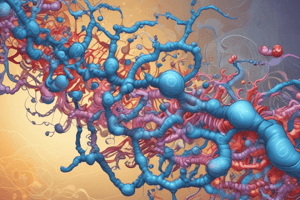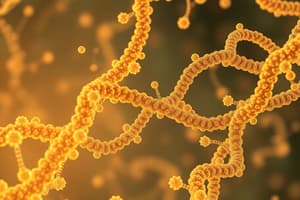Podcast
Questions and Answers
What is the first step in converting genetic information into proteins?
What is the first step in converting genetic information into proteins?
- RNA processing
- Translation
- Transcription (correct)
- Ribosome binding
What is the function of RNA polymerase in transcription?
What is the function of RNA polymerase in transcription?
- Removes introns from the RNA
- Adds a cap and tail to the RNA
- Transcribes only the non-template DNA strand
- Catalyzes the production of RNA complementary to the template DNA strand (correct)
What is the role of exons and introns in eukaryotic genes?
What is the role of exons and introns in eukaryotic genes?
- Exons are non-coding regions, while introns code for proteins
- Exons are removed during RNA processing, while introns code for proteins
- Exons and introns both code for proteins
- Exons code for proteins, while introns are non-coding regions (correct)
What is the function of transfer RNAs (tRNAs) during protein synthesis?
What is the function of transfer RNAs (tRNAs) during protein synthesis?
What is the base sequence of RNA compared to the DNA template strand during transcription?
What is the base sequence of RNA compared to the DNA template strand during transcription?
What replaces Thymine (T) in RNA?
What replaces Thymine (T) in RNA?
What is the function of the non-template DNA strand during transcription?
What is the function of the non-template DNA strand during transcription?
What happens to the regions coded by introns during RNA processing?
What happens to the regions coded by introns during RNA processing?
Which type of polymerase performs template-directed synthesis in the 5' to 3' direction without requiring a primer?
Which type of polymerase performs template-directed synthesis in the 5' to 3' direction without requiring a primer?
How many types of RNA polymerases do eukaryotes have?
How many types of RNA polymerases do eukaryotes have?
What is the function of the protein subunit sigma in transcription initiation?
What is the function of the protein subunit sigma in transcription initiation?
What do bacterial promoters consist of?
What do bacterial promoters consist of?
What performs a similar function to sigma in transcription initiation in eukaryotes?
What performs a similar function to sigma in transcription initiation in eukaryotes?
What is the product of transcription in eukaryotes?
What is the product of transcription in eukaryotes?
What are the noncoding regions in eukaryotic genes called?
What are the noncoding regions in eukaryotic genes called?
Where does the processing of mRNAs occur in eukaryotes before translation?
Where does the processing of mRNAs occur in eukaryotes before translation?
Which molecule was proposed by Francis and Crick to hold amino acids in place while interacting directly with a codon in mRNA?
Which molecule was proposed by Francis and Crick to hold amino acids in place while interacting directly with a codon in mRNA?
What is required to attach tRNA to an amino acid?
What is required to attach tRNA to an amino acid?
What is the structure of transfer RNA (tRNA) that allows it to bind to an amino acid and base pair with the mRNA codon?
What is the structure of transfer RNA (tRNA) that allows it to bind to an amino acid and base pair with the mRNA codon?
What is the role of the A site within the ribosome during translation?
What is the role of the A site within the ribosome during translation?
What is the function of the active site of the ribosome?
What is the function of the active site of the ribosome?
How many tRNAs are there in most cells?
How many tRNAs are there in most cells?
What is the role of elongation factors during translocation in translation?
What is the role of elongation factors during translocation in translation?
What is the last phase of translation involving the release factor?
What is the last phase of translation involving the release factor?
What does the ribosome contain for mRNA positioning and peptide bond formation?
What does the ribosome contain for mRNA positioning and peptide bond formation?
What is the function of RNA polymerase in transcription?
What is the function of RNA polymerase in transcription?
What are the noncoding regions in eukaryotic genes called?
What are the noncoding regions in eukaryotic genes called?
In which direction does RNA polymerase perform template-directed synthesis?
In which direction does RNA polymerase perform template-directed synthesis?
What is the role of the protein subunit sigma in transcription initiation?
What is the role of the protein subunit sigma in transcription initiation?
What is the product of transcription in eukaryotes?
What is the product of transcription in eukaryotes?
What is the last phase of transcription?
What is the last phase of transcription?
Where does the processing of mRNAs occur in eukaryotes before translation?
Where does the processing of mRNAs occur in eukaryotes before translation?
What are the coding regions in eukaryotic genes called?
What are the coding regions in eukaryotic genes called?
What is the function of the 5' cap and poly(A) tail in mRNA processing?
What is the function of the 5' cap and poly(A) tail in mRNA processing?
What happens to the regions coded by introns during RNA processing?
What happens to the regions coded by introns during RNA processing?
What is the role of transfer RNA (tRNA) in protein synthesis?
What is the role of transfer RNA (tRNA) in protein synthesis?
What is the function of the active site of the ribosome during translation?
What is the function of the active site of the ribosome during translation?
What allows transfer RNA (tRNA) to successfully bind to different codons?
What allows transfer RNA (tRNA) to successfully bind to different codons?
What is the first phase of translation?
What is the first phase of translation?
What is the function of elongation factors during translocation in translation?
What is the function of elongation factors during translocation in translation?
What is the structure of transfer RNA (tRNA) that allows it to bind to an amino acid and base pair with the mRNA codon?
What is the structure of transfer RNA (tRNA) that allows it to bind to an amino acid and base pair with the mRNA codon?
What is the role of the E site within the ribosome during translation?
What is the role of the E site within the ribosome during translation?
What is required to attach tRNA to an amino acid?
What is required to attach tRNA to an amino acid?
What is the function of aminoacyl tRNA synthetases?
What is the function of aminoacyl tRNA synthetases?
What is the function of the small and large subunits of the ribosome?
What is the function of the small and large subunits of the ribosome?
What is the function of the cap and tail added to the ends of the RNA during RNA processing?
What is the function of the cap and tail added to the ends of the RNA during RNA processing?
What is the role of the non-template, or coding strand, during transcription?
What is the role of the non-template, or coding strand, during transcription?
What is the function of transfer RNAs (tRNAs) during protein synthesis?
What is the function of transfer RNAs (tRNAs) during protein synthesis?
What is the function of the tRNA anticodon during protein synthesis?
What is the function of the tRNA anticodon during protein synthesis?
What is the central dogma of molecular biology?
What is the central dogma of molecular biology?
What is the first step in converting genetic information into proteins?
What is the first step in converting genetic information into proteins?
What is the base sequence of the RNA compared to the DNA template strand during transcription?
What is the base sequence of the RNA compared to the DNA template strand during transcription?
What is the function of RNA polymerase in transcription?
What is the function of RNA polymerase in transcription?
What is the role of exons and introns in eukaryotic genes?
What is the role of exons and introns in eukaryotic genes?
What is the function of the cap and tail added to the ends of the RNA during RNA processing?
What is the function of the cap and tail added to the ends of the RNA during RNA processing?
Flashcards are hidden until you start studying
Study Notes
The Role of tRNA, Ribosomes, and Translation in Protein Synthesis
- Francis and Crick proposed the role of an adapter molecule in holding amino acids in place while interacting directly with a codon in mRNA. This adapter molecule was later identified as transfer RNA (tRNA).
- ATP is required to attach tRNA to an amino acid, and aminoacyl tRNA synthetases catalyze the addition of amino acids to tRNAs.
- Experiments with radioactive amino acids confirmed that they are lost from tRNAs and incorporated into polypeptides synthesized in ribosomes.
- Transfer RNA's structure includes a CCA sequence at the 3' end for amino acid binding and an anticodon that base pairs with the mRNA codon.
- There are approximately 40 tRNAs in most cells, but they can bind successfully to different codons due to the wobble hypothesis.
- Ribosomes contain protein and ribosomal RNA (rRNA) and have small and large subunits for mRNA positioning and peptide bond formation, respectively.
- During translation, aminoacyl tRNAs line up within the ribosome, with the A site accepting the aminoacyl tRNA, the P site forming peptide bonds, and the E site releasing tRNAs.
- The ribosome synthesizes proteins in a three-step sequence involving the entry of aminoacyl tRNA, peptide bond formation, and translocation.
- Translation has three phases: initiation at the start codon, elongation with aminoacyl tRNA binding, peptide bond formation, and translocation, and termination at a stop codon.
- The active site of the ribosome is ribosomal RNA, making it a ribozyme that catalyzes peptide bond formation.
- Translocation occurs as elongation factors move the mRNA down the ribosome, and the tRNA attached to the growing protein moves to the P site.
- The termination phase involves a release factor catalyzing hydrolysis of the bond linking the tRNA in the P site with the polypeptide chain, and post-translational modifications prepare proteins for cellular functions.
The Role of tRNA, Ribosomes, and Translation in Protein Synthesis
- Francis and Crick proposed the role of an adapter molecule in holding amino acids in place while interacting directly with a codon in mRNA. This adapter molecule was later identified as transfer RNA (tRNA).
- ATP is required to attach tRNA to an amino acid, and aminoacyl tRNA synthetases catalyze the addition of amino acids to tRNAs.
- Experiments with radioactive amino acids confirmed that they are lost from tRNAs and incorporated into polypeptides synthesized in ribosomes.
- Transfer RNA's structure includes a CCA sequence at the 3' end for amino acid binding and an anticodon that base pairs with the mRNA codon.
- There are approximately 40 tRNAs in most cells, but they can bind successfully to different codons due to the wobble hypothesis.
- Ribosomes contain protein and ribosomal RNA (rRNA) and have small and large subunits for mRNA positioning and peptide bond formation, respectively.
- During translation, aminoacyl tRNAs line up within the ribosome, with the A site accepting the aminoacyl tRNA, the P site forming peptide bonds, and the E site releasing tRNAs.
- The ribosome synthesizes proteins in a three-step sequence involving the entry of aminoacyl tRNA, peptide bond formation, and translocation.
- Translation has three phases: initiation at the start codon, elongation with aminoacyl tRNA binding, peptide bond formation, and translocation, and termination at a stop codon.
- The active site of the ribosome is ribosomal RNA, making it a ribozyme that catalyzes peptide bond formation.
- Translocation occurs as elongation factors move the mRNA down the ribosome, and the tRNA attached to the growing protein moves to the P site.
- The termination phase involves a release factor catalyzing hydrolysis of the bond linking the tRNA in the P site with the polypeptide chain, and post-translational modifications prepare proteins for cellular functions.
Studying That Suits You
Use AI to generate personalized quizzes and flashcards to suit your learning preferences.




